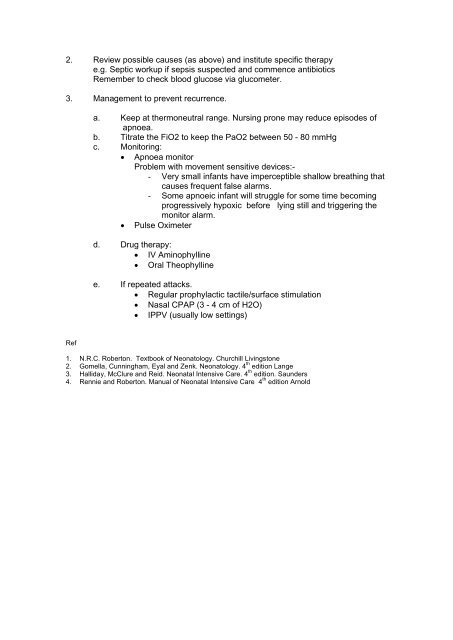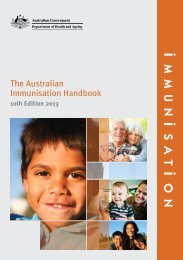Contents Chapter Topic Page Neonatology Respiratory Cardiology
Contents Chapter Topic Page Neonatology Respiratory Cardiology
Contents Chapter Topic Page Neonatology Respiratory Cardiology
Create successful ePaper yourself
Turn your PDF publications into a flip-book with our unique Google optimized e-Paper software.
2. Review possible causes (as above) and institute specific therapy<br />
e.g. Septic workup if sepsis suspected and commence antibiotics<br />
Remember to check blood glucose via glucometer.<br />
3. Management to prevent recurrence.<br />
Ref<br />
a. Keep at thermoneutral range. Nursing prone may reduce episodes of<br />
apnoea.<br />
b. Titrate the FiO2 to keep the PaO2 between 50 - 80 mmHg<br />
c. Monitoring:<br />
Apnoea monitor<br />
Problem with movement sensitive devices:-<br />
- Very small infants have imperceptible shallow breathing that<br />
causes frequent false alarms.<br />
- Some apnoeic infant will struggle for some time becoming<br />
progressively hypoxic before lying still and triggering the<br />
monitor alarm.<br />
Pulse Oximeter<br />
d. Drug therapy:<br />
IV Aminophylline<br />
Oral Theophylline<br />
e. If repeated attacks.<br />
Regular prophylactic tactile/surface stimulation<br />
Nasal CPAP (3 - 4 cm of H2O)<br />
IPPV (usually low settings)<br />
1. N.R.C. Roberton. Textbook of <strong>Neonatology</strong>. Churchill Livingstone<br />
2. Gomella, Cunningham, Eyal and Zenk. <strong>Neonatology</strong>. 4 th edition Lange<br />
3. Halliday, McClure and Reid. Neonatal Intensive Care. 4 th edition. Saunders<br />
4. Rennie and Roberton. Manual of Neonatal Intensive Care 4 th edition Arnold
















